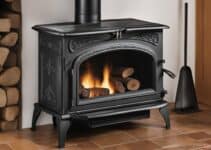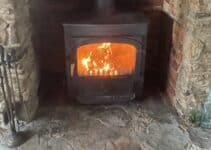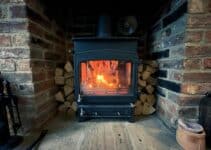Understanding air vents control in log burners has been a game changer for me. It’s the finesse of tweaking the slivers of openings that manipulate oxygen supply, essentially dictating the comportment of flames. This nuanced control is at the heart of wood burner heat management, ensuring log burner efficiency and transforming my home into a sanctuary of warmth.
Rooted in my experience, I have found that the mastery of these air vents is not merely about letting air in or keeping the cold out. It’s an art that balances combustion, heat production, and fuel preservation. Striking this balance means I am not just burning logs; I am choreographing a symphony of air and fire for the ultimate warmth and efficiency within my living space.
The Vital Role of Air Vents in Log Burner Efficiency
As a passionate advocate for log burner ventilation and its integral role in home heating, I’ve come to appreciate the nuanced control air vents offer in optimising stove performance. The choreography of log burner air intake is not just about feeding the flame—it’s the cornerstone of efficiency and energy maximisation.
Understanding the distinctive functions of primary, secondary, and tertiary air supply and their impact on combustion can significantly enhance a log burner’s output. By adjusting these various air vents, I’ve found that it’s possible to achieve significant improvements not only in heat distribution but also in overall stove efficiency.
Here is a closer look at how each type of air supply vent contributes to the optimisation of combustion within a log burner:
- Primary Air Vents: Located typically at the base, these are crucial for igniting the wood and initiating the burn cycle. They regulate the flow of air necessary for the primary combustion of solid fuel.
- Secondary Air Vents: These usually come into play after the wood has been lit, supplying air to maintain higher temperatures necessary for efficient burning and maximum heat output.
- Tertiary Air Vents: Often situated at the back, tertiary vents introduce additional oxygen to facilitate complete combustion, thus improving the stove’s performance and reducing particle emissions.
| Air Vent Type | Location | Function | Contribution to Efficiency |
|---|---|---|---|
| Primary Air Vent | Base of stove | Initial combustion | Essential for starting the fire and establishing burn |
| Secondary Air Vent | Top or sides of stove | High-temperature combustion | Key to sustaining high heat output |
| Tertiary Air Vent | Back of stove | Complete combustion of gases | Increases stove efficiency, minimises emissions |
Achieving up to 60% of the total energy release from wood simply by tweaking how and when I manipulate these vents underscores their importance. My routine now includes careful observation and adjustment of the air supply to maintain an optimal burn rate and temperature, underlining the critical role that proper log burner air intake plays.
By mastering the interplay of air supply and combustion, I am empowered to leverage my log burner not just for warmth, but as a testament to sustainable, efficient home heating practices.
The deployment of thoughtful ventilation strategies establishes a harmonious balance between fuel consumption and cosy, radiant warmth, epitomising the true potential of a finely-tuned log burner system.
Understanding the Mechanics of Log Burner Air Vents
As an individual fascinated by the nuanced operation of log burners, I’ve taken a particular interest in the combustion process in stoves. A fundamental component of this process is the regulation of airflow, a factor governed by the seemingly inconspicuous yet potent log burner air vents. To fully grasp how wood burner vents work, it’s imperative to acknowledge that these vents are not just passive openings but rather sophisticated mechanisms pivotal for log burner airflow control.
Let’s dive into the operational specifics of these vents. Initially, the primary air is what the burner relies on to start the fire. This air stream directly feeds the flames from beneath the fuel, enabling them to gain strength and stability. As the temperature in the wood burner increases, the role of the secondary air comes into play. It enters from above, optimising combustion by efficiently burning the gases released from the wood. Lastly, the tertiary air assists in further enhancing the efficiency and cleanliness of the burn, targeting any residual particles that escaped the initial combustion stages.
Proper manipulation of these vents throughout the burn cycle allows me not just to enjoy the mesmerising flames but also to effect a more eco-friendly and fuel-efficient operation. By adjusting these air sources, I fine-tune the combustion process within my stove, ensuring I extract every ounce of heat from the wood while minimising waste and emissions.
And now, for a deeper understanding, let’s look at a typical cycle adjusted for air vent control:
- Initiation of combustion: Primary air fully opened to establish the fire.
- Development of the fire bed: Primary air reduced, secondary air increased to encourage a hearty flame.
- Optimise full combustion: Tertiary air adjusted to sustain a clean burn and high-efficiency heat output.
The effective management of these vents doesn’t just provide warmth but also contributes to the longevity of the stove and a healthier environment. As simple as these mechanisms may seem, their mastery is nothing short of an art, intricately tied to the natural elements that fuel their flames.
Air Vents Control in Log Burners: Primary, Secondary and Tertiary Airflows
Mastering the precise control of air vents in a log burner is critical for achieving an efficient and eco-friendly burn. Proper management of airflow not only ramps up the heat output but also plays a pivotal role in reducing harmful stove emissions. Let’s delve into the functionalities of the different airflows and how they contribute to the overall efficiency of a log burner.
Primary Air Supply and Its Function
The log burner primary air vent is the unsung hero when it comes to firing up my burner. Located at the base of the firebox, it is directly responsible for primary combustion. As the controller of the initial flow of air that the logs receive, it supplies the needed oxygen to kickstart the fire, which begins as low as 282 degrees celsius. This air is essential to get the flames burning vigorously and to steadily bring the log burner up to the optimum performance temperature.
Secondary Air Supply: Enhancing Combustion
Once I’ve got my log burner sufficiently heated and the primary combustion is stable, the secondary air vent comes into play. This secondary combustion occurs at higher temperatures of approximately 593 degrees celsius, where the secondary air vent allows just the right amount of oxygen to maintain a robust flame and stimulate a process that contributes to around 60% of the log burner heat enhancement. It’s a key factor in reinforcing the efficiency of my stove and maximising heat output.
Tertiary Air: Boosting Efficiency and Reducing Emissions
Finally, there’s the tertiary air which bolsters log burner efficiency through tertiary air circulation. This crucial air supply enters typically through an aperture situated at the rear of the firebox. It’s tasked with ensuring the full combustion of gases, which not only elevates the heat released by the stove but also plays a significant role in stove emissions reduction. Tertiary air is the element that refines the combustion process, ensuring my log burner operates cleanly and more efficiently.
| Airflow Type | Temperature Activation (Approx.) | Purpose | Benefits |
|---|---|---|---|
| Primary Air Vent | 282°C | Initiates primary combustion | Effective log burner firing up |
| Secondary Air Vent | 593°C | Facilitates secondary combustion | Maximises heat output |
| Tertiary Air Supply | N/A (Post-secondary combustion) | Ensures complete combustion of gases | Enhances efficiency and reduces emissions |
In my experience, understanding and adjusting these three types of airflows is crucial for anyone looking to optimise their log burner’s performance. Whether I’m aiming for a quick warm-up or a steady burn throughout the evening, manipulating my log burner’s primary, secondary, and tertiary air vents is the key to a successful burn.
Log Burner Airflow Control: The Key to Optimising Heat Output
Understanding log burner air regulation is crucial to achieving an efficient stove operation and optimising wood burner heat. As I’ve experienced, the manipulation of air supply is less about adhering to a set of rigid guidelines and more about grasping how different levels of oxygen can impact the burn rate and subsequent heat generation. When I increase the air supply, the burner responds with a surge in heat output, which can be ideal during the bitterest winter evenings. However, this is often at the cost of heightened fuel consumption and can lead to excessive heat loss if not managed correctly.
On the opposite spectrum, I’ve found that reducing the oxygen supply is beneficial for conserving fuel – an essential consideration for long burn periods and economic fuel usage. Yet this practice calls for precise monitoring to avoid the fire diminishing to mere smouldering embers. The balance between these two states is delicate and necessitates experience and attentiveness towards the fire’s behaviour. Thus the skill of regulating a log burner’s air intake is both an art and a science.
| Oxygen Level | Impact on Burn Rate | Heat Output | Fuel Efficiency |
|---|---|---|---|
| High Air Supply | Increased Burn Rate | High | Lowered |
| Low Air Supply | Reduced Burn Rate | Moderate to Low | Improved |
Let me illustrate with an example from my own experience – I recall one chilly evening when my objective was to maximise warmth without expending a large quantity of wood. By incrementally closing the air intake and observing the flames, I was able to maintain a steady heat without overwhelming the room or squandering resources.
Mastering the airflow control of a log burner, I have learned, lies in observation and adjustment, rather than rigorous adherence to a prescribed set of rules.
This artful approach to air regulation empowers a hands-on experience, where the very atmosphere of my home is shaped by how I interact with the burner’s air vents. The richness of a warm, glowing fire, an embodiment of comfort during winter’s reign, is thus under my thoughtful command.
Accurate Air Regulation in Log Burners for Sustained Burning
Mastering the intricacies of controlling air vents in log burners is crucial for effective wood burner handling. The skill lies in the ability to provide a consistent heat maintenance while seeking to maximise fuel efficiency. Through careful log burner draft control, we can achieve a prolonged and satisfying burn without the risk of avoid overburning.
In my experience, the journey towards log burner fire management begins with a clear understanding of each phase of the fire’s life cycle and corresponding vent adjustments. Here’s how I approach this process:
Adjustment Techniques for Controllable Air Vents
The demand for oxygen fluctuates during a burn. Therefore, the ability to adjust your stove’s airflow is essential. When lighting my log burner, I ensure all log burner air dampers are fully open, enhancing the kindling’s combustion. As the fire stabilises, I gradually close the vents – an adjustment that is crucial to maintaining the right temperature and fuel burn rate.
Maintaining the Ideal Heat Output with Log Burner Vents
Each log burner has its quirks, but finding that sweet spot for vent positioning is a game changer. By adjusting the vents in small increments, I can fine-tune the fire’s intensity. This delicate dance ensures that my room is neither an icebox nor a sauna, but rather a haven of warmth.
Preventing Overburn with Effective Airflow Management
One of my top priorities is to prevent excessive consumption of logs. I closely monitor the fire and adjust the air vents to avoid an overzealous burn that could lead to unnecessary heat and energy loss. This attentive stove airflow adjustment not only preserves my fuel stockpile but also extends the pleasure of the fire’s glow.
| Stage of Burn | Vent Position | Heat Output |
|---|---|---|
| Ignition | Fully Open | High to establish fire |
| Stable Burning | Partially Closed | Moderate for fuel conservation |
| Sustained Glow | Minimally Open | Low to maintain embers |
By applying these principles of air regulation, I am able to enjoy my log burner’s warmth for hours on end, ensuring those cold nights are a thing of the past. With patience and practice, achieving consistent heat maintenance becomes second nature, transforming the way you experience your wood burner.
Installation and Positioning: Maximising Log Burner Air Circulation
When it comes to log burner installation and stove positioning, it’s not merely about aesthetic appeal or tapping into the allure of a cosy hearth. My professional interest pushes me to dive deep into the strategies that significantly enhance air circulation, crucial for the efficacy of the stove’s combustion process. As I’ve learned, the positioning within a room determines how air flows around the stove, which in turn, impacts the stove’s ability to efficiently heat the space.
Following the expert recommendations from leading manufacturers, I understand that creating a clear pathway for the air to move is paramount. This means ensuring that the log burner is not only set in a position where combustion air can easily be drawn in but also where the warm air can circulate unimpeded throughout the room. For instance, placing a stove in close proximity to a cold external wall might detrimentally affect stove performance.
Moreover, the height at which the stove is installed, and its relation to other items of furniture, can significantly affect how air circulates around a room:
- Installing a stove at an elevated position can ensure heat is distributed more evenly across the room space.
- Free space around the stove allows for better conveyance of heat, preventing ‘dead spots’ where cold air might remain stagnant.
- Understanding the natural airflow within a room assists in placing the stove in such a way as to bolster its effectiveness.
Through diligent research and practical experience, I’ve recognised the critical role of stove positioning in augmenting air circulation. It’s not just about reducing cold spots, but also about enhancing the air flow to and from the log burner’s air vents – both are symbiotic in achieving a warm and inviting ambience.
In conclusion, optimal log burner installation and strategic stove positioning are non-negotiable components for maximising the performance of one’s stove. As someone deeply entrenched in the intricacies of how these heating systems work, I can attest to the profound difference that careful planning and expert positioning make in enhancing air circulation and the overall enjoyment of your wood burning pleasure.
Tips for Controlling Air Vents in Log Burners: Practical Advice
When it comes to starting a log burner fire, the correct use of air vents is critical for establishing an efficient and robust flame. Through meticulous initial fire setup and regular stove upkeep, I can ensure my log burner operates at peak performance, providing consistent warmth and energy efficiency in my home.
Starting the Fire: The Right Approach
For starters, I adopt the best practices for lighting up my log burner. I never underestimate the importance of using air vents correctly; hence, I initiate the process by fully opening all air vents. This provides the high levels of oxygen needed for the kindling to catch fire swiftly. Gradually, I add small logs, building up the fire at a consistent rate and making necessary adjustments to the air supply, ensuring a strong, efficient flame.
Long-Term Maintenance and Airflow Checks
Longevity and performance of the stove are maintained through regular log burner air damper maintenance and airflow efficiency checks. I examine the condition of essential components such as fire bricks and the fire rope, replacing them when needed. This not only aids in effective heat regulation but also prevents potential ventilation issues for the future.
Understanding Signs of Poor Ventilation and Taking Corrective Action
Identifying log burner ventilation issues early is paramount in addressing air intake problems. Symptoms such as a laboured flame or excessive smoke output signal me to act swiftly. To combat this, I make corrective vent adjustments, ensuring the airflow is optimised for ideal combustion. Sometimes, I may need to reposition logs for better air circulation or refer to the manual for vent regulation specifics.
| Issue | Indicator | Action |
|---|---|---|
| Airflow Restriction | Smoke not drawing | Open air vents, check flue |
| Unsustainable Flame | Fire dies quickly | Adjust logs, increase air |
| Oxygen Deficiency | Smouldering fire | Fully open air vents |
| Overheating | Rapid fuel consumption | Reduce air intake |
Conclusion
In mastering the intricate dance of air vent control in my wood burner, I have charted a course towards elevated stove operation optimisation. The journey through understanding how each air vent affects the combustion process has been enlightening. It sheds light on how pivotal a role they play in not only achieving wood burner efficiency but also in fuel conservation. It is this precise calibration of oxygen supply that underscores the efficacy of my log burner’s performance, ensuring that it delivers enduring warmth and comfort to my living space.
Over time, through vigilant observation and gradual adjustments, I have gained air vent control mastery. This expertise not only contributes to the economical usage of wood but also secures a consistent and reliable heat output. My commitment to routine stove maintenance further encapsulates my dedication to preserving the log burner’s condition, allowing it to function at its best – a testament to the value of thorough upkeep in the lifecycle of any log burner.
In sum, the seamless integration of scrupulous air vent regulation and steadfast maintenance routines guarantees that my log burner stands as a paragon of heating efficiency. As the seasons change and the cool whisper of winter beckons, I rest assured knowing my wood burner is prepared to perform with exceptional poise, warming my home and epitomising the zenith of stove operation optimisation.



